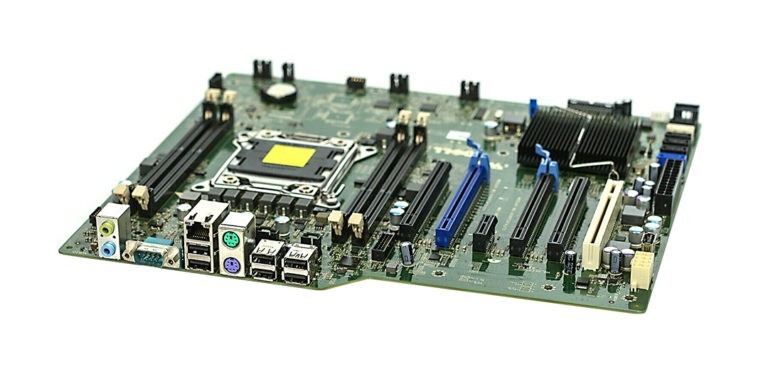The motherboard is the core of the PC and furthermore the most ignored piece of the equipment. The fundamental motivation behind the motherboard is to interface all pieces of a PC, for example, memory, processor, plates and different gadgets in a superior and quicker way. Not at all like other equipment gadgets, advancement of the used motherboard is extremely novel and enormously affects the market.
The goals of this study were to portray the main segments of the motherboard and its improvement beginning from chipsets, through memory, processor, which is one of the parts that are chosen first while planning a PC, to the transport and different openings
Making The Base Of A Motherboard
Everything begins with the PCB or printed circuit board. Layers of extremely muddled cuts of fiberglass are stacked/remained along with a pitch to frame one strong layer.
This new, single fiberglass layer will then, at that point, be covered with a layer of copper on both the top and base sides. A synthetic called photoresist, a light-delicate material that shapes a copper-carved follow on the PCB when presented to light, is then covered on top of the copper layer.
Subsequent to covering the copper with photoresist, an example covering explicit pieces of the layer is then put on top of it prior to uncovering the whole chunk to UV light. The board is then washed to eliminate the revealed pieces of the copper layer, uncovering the nearly complete motherboard.
What You Need to Know About BIOS
The principal thing you see when your PC fires up is the BIOS, or Basic Input/Output System. This is the firmware that heaps before your working framework boots up, and it’s answerable for firing up and testing all associated equipment.
However, frequently alluded to as the BIOS by clients and motherboard names the same, the firmware on current motherboards is commonly UEFI. This more adaptable climate flaunts numerous easy to use enhancements, for example, support for bigger capacity parts, speedier boot-up, and a cutting edge GUI (graphical UI).
Motherboard producers frequently add UEFI utilities that smooth out the method involved with overclocking the PC’s CPU or memory and give supportive presets. They may likewise highlight an adapted appearance, add logging and screen capture highlights, work on processes like booting from another drive, and show screen memory, temperature, and fan speeds.
UEFI additionally upholds more seasoned highlights of the BIOS. Clients can boot into Legacy mode (otherwise called CSM, or Compatibility Support Module) to get to the exemplary BIOS, which might tackle similarity issues with more seasoned working projects or utilities. Nonetheless, when clients boot in Legacy mode, they clearly lose the cutting edge advantages of UEFI, for example, support for parcels over 2TB
What motherboards are viable with AMD chipsets?
Not at all like Intel, AMD has figured out how to keep up with the AM4 attachment straight up to its most recent Zen 3-based Ryzen 5000 series CPUs. In this way, on the off chance that you are making arrangements for another PC with an AMD processor you have an assortment of motherboard choices including both the 500-series (X570, B550) and 400-series (X470, B450), and, surprisingly, more seasoned X370, B350, and A320 sheets. Do take note of that assuming you are going for the Ryzen 5000 on sheets outside the 500 series, it is obligatory to download and introduce the most recent BIOS update prior to introducing the processor.
Do all motherboards support overclocking?
With regards to Intel, The Z-series loads up (Z690, Z590) offer the capacity to overclock the CPU as well as the memory. With the presentation of twelfth gen, Intel currently offers memory overclocking on the mid to low-end B660, H670, and H610. It is ideal to ensure you check for overclocking abilities by making a beeline for the item page on the merchant’s true site. Additionally, the X570 loads up are more reasonable for securely overclocking AMD chips.
Why we picked the ASRock B450M Steel Legend:
You don’t get state of the art highlights with a B450M motherboard, yet they are truly reasonable, making them a decent choice for somebody who isn’t anticipating doing weighty overclocking and doesn’t require first in class highlights. The ASRock B450M Steel Legend is a M-ATX board that includes a high contrast cover with three blocks of aluminum heatsinks for the VRMs and furthermore the B450. It even consolidates some RGB lighting for added feel. The board includes a six-power stage plan and backing for up to 128GB DDR4-3533+ OC memory relying upon the CPU utilized.
The essential PCI-E 3.0 opening runs at full X16 speed and the space highlights steel support for additional reinforcing. There is likewise an optional PCI-E 2.0 X16 space running at x4 speed. For capacity, there are two M.2 openings and four SATA 3 ports, and quite, the second M.2 space just backings M.2 SATA drives and offers data transmission with the third SATA 3 port so assuming it is possible that one is being used the other one is impaired. The back I/O appears to be strong with two USB 3.1 Gen2 (Type-A and Type-C), four USB 3.1 Gen1 Type-A ports, HDMI and DisplayPort, Ethernet, gold-plated sound ports, and, surprisingly, a PS/2 port for heritage peripherals.
For more information visit buzzfreek.com









